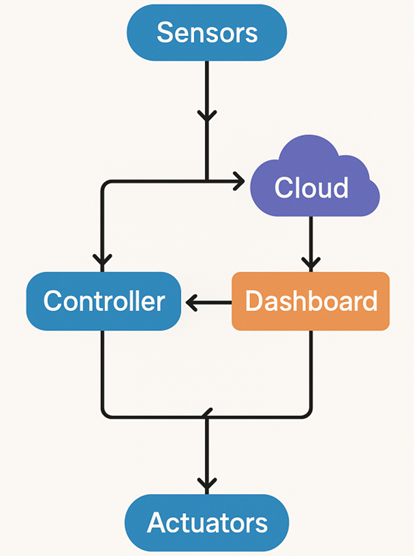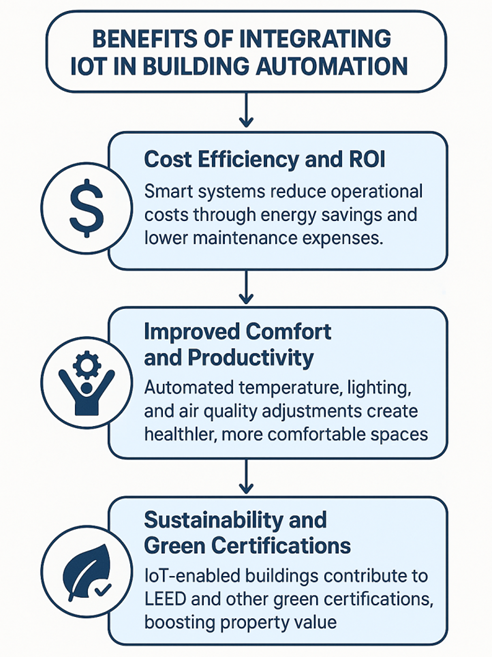Introduction to Building Automation and IoT
The way we design and operate buildings has transformed dramatically in recent years. At the heart of this transformation lies the powerful fusion of building automation and the Internet of Things (IoT). Together, they are redefining how we manage energy, comfort, safety, and overall efficiency in residential, commercial, and industrial spaces.
Building automation ensures that critical systems — such as lighting, HVAC (heating, ventilation, and air conditioning), elevators, and security — work seamlessly and reliably. IoT, on the other hand, introduces a new layer of intelligence by enabling these systems to connect, communicate, and respond dynamically to real-world conditions. With sensors, data analytics, and cloud integration, IoT allows buildings to “think,” learn patterns of usage, and adapt their operations in real-time.
This synergy has given rise to the modern concept of smart buildings. Instead of being static infrastructures, buildings are now evolving into responsive ecosystems that prioritize sustainability, occupant comfort, and cost-effectiveness. For example, smart sensors can automatically dim lights when natural daylight is sufficient, adjust HVAC systems based on occupancy, or trigger security protocols in response to unusual activity.
Ultimately, the integration of building automation and IoT is not just a technological upgrade — it represents a shift toward smarter urban living. By reducing energy waste, improving safety, and creating more personalized environments, these technologies are paving the way for greener cities and a more sustainable future.
The Evolution of Building Automation Systems
From Manual Controls to Smart Buildings
Traditionally, building operations relied heavily on manual controls and simple timers. Facility managers had to adjust thermostats, lighting, and security systems individually, often leading to inefficiencies and higher operational costs. As technology advanced, the concept of automation began to take hold, aiming to simplify and optimize these processes.
The introduction of Building Automation Systems (BAS) in the late 20th century was a game-changer. BAS offered centralized control over critical systems such as HVAC, lighting, fire safety, and security, making buildings more efficient, comfortable, and easier to manage.
Today, the Internet of Things (IoT) has taken BAS to an entirely new level. By connecting everyday devices and systems to the internet, IoT enables real-time data exchange, predictive maintenance, and smarter decision-making. Rather than operating on fixed schedules or manual inputs, buildings can now “sense” conditions, learn user behavior, and optimize performance automatically.
Key Milestones in IoT Adoption in Buildings
- 1970s – The introduction of programmable logic controllers (PLCs) revolutionized industrial automation and laid the groundwork for digital building control.
- 1990s – The rise of networked BAS allowed centralized management of HVAC, lighting, and security across large facilities.
- 2010s – The boom of IoT-enabled devices and sensors made smart buildings mainstream, with real-time monitoring and cloud-based analytics.
- 2020s – The integration of AI-driven building management systems has ushered in a new era of predictive, self-learning, and fully automated buildings.
This journey from manual switches to intelligent ecosystems highlights how far building management has evolved — and how closely it is tied to the progress of digital technologies.
Core Components of Building Automation Systems (BAS)
Sensors and Smart Devices
At the foundation of any smart building are sensors. These devices constantly monitor critical parameters such as temperature, humidity, air quality, occupancy, motion, and energy consumption. The collected data provides a real-time picture of building conditions, allowing the system to adapt automatically. For example, occupancy sensors can detect whether a room is in use and adjust lighting or HVAC settings accordingly, reducing unnecessary energy waste.
Actuators and Controllers
While sensors gather information, controllers act as the “brains” of the system. They process sensor data, apply logic or algorithms, and decide what actions need to be taken. Actuators then carry out these commands physically — such as opening a damper, dimming the lights, or adjusting a thermostat. This sensor-controller-actuator loop ensures that buildings don’t just monitor conditions, but also respond intelligently to them.
Communication Protocols
For a building automation system to function smoothly, its diverse devices must be able to “speak the same language.” This is where communication protocols come in. Standards like BACnet, Modbus, KNX, and Zigbee make it possible for equipment from different manufacturers to interconnect and share data seamlessly. These protocols also ensure scalability — allowing new devices and systems to be added without disrupting existing operations.
How IoT Enhances Building Automation
Real-Time Data Monitoring
One of the greatest advantages of IoT in smart buildings is real-time visibility. Building managers can instantly monitor energy usage, occupancy trends, air quality, and system performance through dashboards and mobile apps. This live data makes it possible to respond immediately to issues such as sudden energy spikes, unusual occupancy patterns, or poor ventilation, ensuring both efficiency and occupant comfort.
Predictive Maintenance
Traditional maintenance approaches often relied on scheduled servicing or reactive repairs after a failure occurred. IoT-enabled systems change this by enabling predictive maintenance. By continuously analyzing sensor data from equipment, the system can detect early warning signs — such as abnormal vibration, rising energy consumption, or declining efficiency. This allows facility teams to address potential problems before breakdowns happen, reducing downtime, extending equipment lifespan, and lowering repair costs.
Cloud and Edge Computing in Smart Buildings
Modern smart buildings leverage both cloud and edge computing to balance efficiency and responsiveness.
- Cloud platforms provide centralized data storage, advanced analytics, and AI-driven insights. They allow building operators to compare performance across multiple facilities, optimize energy use, and generate long-term reports.
- Edge computing, on the other hand, processes data closer to the devices themselves. This enables faster, localized decision-making, which is especially critical for functions like real-time HVAC adjustments, security responses, or lighting controls where delays are unacceptable.
Together, cloud and edge computing create a hybrid ecosystem — where strategic, data-heavy analysis happens in the cloud, while time-sensitive decisions are executed instantly at the edge.

Applications of Building Automation and IoT
Energy Management and Sustainability
Energy is one of the largest costs in building operations. IoT-enabled sensors and smart meters track real-time energy usage, allowing managers to identify inefficiencies such as unnecessary equipment operation, peak load spikes, or energy-hungry zones. With this data, buildings can automatically optimize energy distribution, integrate renewable sources like solar panels, and achieve significant reductions in both costs and carbon footprint.
Smart HVAC and Climate Control
Heating, ventilation, and air conditioning systems are traditionally among the most energy-intensive in a building. With IoT integration, HVAC systems can adjust dynamically based on occupancy, weather conditions, and even user preferences. For instance, if sensors detect that a conference room is unoccupied, the system can reduce heating or cooling in that space — ensuring comfort without wasting energy.
Security and Access Control
Modern security is no longer limited to cameras and locks. IoT enables smart surveillance systems, biometric scanners, motion detectors, and keyless entry solutions that work together seamlessly. Data from these systems can be monitored in real-time, with AI-enabled alerts for unusual activity, ensuring higher levels of safety and faster incident response.
Lighting and Occupancy Optimization
Smart lighting systems use motion and occupancy sensors to turn lights on only when needed and adjust brightness based on natural daylight availability. In large commercial or industrial settings, this can lead to substantial electricity savings. Additionally, customizable lighting enhances occupant comfort, boosting both productivity in workplaces and well-being in residential spaces.

Challenges and Risks of IoT in Building Automation
Cybersecurity Threats
With thousands of connected devices in a smart building, each endpoint can become a potential entry point for cyberattacks. If not properly secured, hackers could gain access to critical systems like HVAC, lighting, or even security cameras — posing risks to both safety and privacy. Implementing strong encryption, network segmentation, and regular software updates is essential to safeguard building automation systems.
Data Privacy Concerns
Smart buildings rely on sensors that collect vast amounts of information — from occupancy patterns and energy use to biometric access data. While this data helps optimize efficiency and comfort, it also raises privacy concerns. Mismanagement or unauthorized access could expose sensitive information about building occupants. Clear policies on data ownership, storage, and anonymization are necessary to maintain trust and compliance with privacy regulations.
Integration and Interoperability Issues
One of the biggest hurdles in IoT adoption is ensuring that devices and systems from different manufacturers can communicate seamlessly. While protocols like BACnet, Modbus, KNX, and Zigbee help standardize communication, not all devices are fully compatible. Without proper planning, integration can lead to fragmented systems, higher costs, and reduced efficiency. Selecting scalable, standards-based solutions is key to overcoming this challenge.
Case Studies of Smart Buildings Using IoT
Commercial Office Spaces
Global corporations are leading the way in adopting IoT to create energy-efficient, employee-friendly workplaces. Smart lighting systems automatically adjust brightness based on daylight, while occupancy sensors optimize HVAC usage in real time. Some companies report up to 30% reductions in energy bills, alongside improvements in employee productivity due to enhanced comfort and better indoor air quality.
Healthcare Facilities
Hospitals and healthcare centers rely heavily on precise climate control, hygiene, and patient comfort. IoT solutions help monitor and regulate temperature, humidity, and air filtration in critical areas such as operating rooms. In addition, smart sensors track equipment usage and maintenance needs, ensuring that life-saving devices are always in peak condition. This not only improves patient outcomes but also enhances operational efficiency.
Residential Smart Homes
In the residential sector, IoT has become part of daily life. From smart thermostats that learn a family’s preferences to voice assistants that control lighting and appliances, IoT makes homes more convenient, secure, and energy-efficient. For instance, connected door locks and cameras improve safety, while intelligent appliances reduce electricity consumption during peak hours — empowering homeowners to live smarter and greener.
The Future of Building Automation and IoT
Role of AI and Machine Learning
The next evolution of smart buildings lies in artificial intelligence (AI) and machine learning. These technologies enable buildings to learn usage patterns, predict occupant needs, and optimize performance without manual input. For example, AI-driven HVAC systems can forecast heating and cooling demands based on weather data, occupancy trends, and historical patterns, making buildings truly autonomous and adaptive.
Digital Twins and Virtual Modeling
The concept of digital twins — virtual replicas of physical buildings — is transforming how facilities are designed and managed. By simulating energy usage, occupant behavior, and system interactions, digital twins allow engineers to test efficiency strategies before real-world implementation. This reduces costs, minimizes risks, and accelerates the journey toward highly optimized smart buildings.
Autonomous Buildings of Tomorrow
Looking ahead, the ultimate vision is self-regulating, energy-positive buildings. These structures will not only optimize internal operations but also generate excess energy through renewable sources like solar and wind. Advanced IoT networks, coupled with AI and edge computing, will allow buildings to respond to environmental conditions, manage resources, and even contribute surplus energy back to the grid. Such autonomous, sustainable buildings could soon become the global standard for urban development.
Conclusion: Why Building Automation and IoT Matter Today
The fusion of building automation and IoT is transforming the way we design, operate, and experience buildings. No longer just static structures, modern buildings are evolving into intelligent ecosystems that adapt to human needs, conserve resources, and operate with remarkable efficiency. From reducing energy bills and enabling predictive maintenance to enhancing comfort, safety, and sustainability, IoT-powered automation is truly a game-changer.
Of course, challenges such as cybersecurity risks, data privacy concerns, and system integration hurdles still need to be addressed. Yet, the advantages far outweigh the risks — especially as advances in AI, edge computing, and digital twins continue to strengthen the resilience and intelligence of smart buildings.
As technology evolves, the dream of fully autonomous, eco-friendly, energy-positive buildings is no longer a distant vision — it is already taking shape around us. The buildings of tomorrow will not only support their occupants but also actively contribute to a more sustainable, connected, and efficient world.